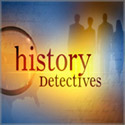How to Appraise an Object
The basic steps are Identify, History, Research, Condition, Rarity and Comparable.
IDENTIFY
I start my evaluation of an object by simply asking myself what it it?
You do not need to be an expert to do this. Consider the size, material, style and condition. Look for evidence of attribution, such as a signature, stamp, copyright or maker markings. Once you know any of these, it can help you IDENTIFY the piece, which is the first step of appraising.
HISTORY
Once you think you have identified the piece, try to learn the HISTORY.
How old is it? What is/was it used for? What is it’s historical connection? How important was this object at the time? Is is connected to a historical event, person or place?
RESEARCH
Now we know a bit about the object and the history, but we need more. Time to research.
The best place to start this RESEARCH is the internet. You can get quick facts and good leads. Usually to get the best information you will need to turn to primary sources. Go to the library, historical society or an archive to help you research.
CONDITION
After I now know what I have and it’s history, I look at the next important component. CONDITION.
When appraising an item, this is key, as if the condition is terrible, it can literally deem the piece worthless. Pay attention to everything, tears, wear, rust, dirt, dents, chips and even restoration. Each of these can decrease the value of an object by 50%.
RARITY
RARTIY, can add to the value of the piece.
Start searching on line auctions to see if you piece is readily available. You will be able to determine quickly how rare it actually is.
COMPARABLES
You now need to see what other similar items are selling for.
Look for COMPARABLES at on line auctions, which will help you see what your piece its worth. It is important to remember to only look at the selling price. The asking price means nothing. Only when an object sells to a willing buyer from a willing seller, can we use that price as an appraisal comparable. If you can not find a comparable in an online auction, turn to auction catalogues and look through their price list. Lastly, go to flea markets, galleries or stores to see what they are asking for similar objects.
HAVE FUN!!!
Most importantly, have fun! Enjoy the hunt, the search for information and the final result! No matter what, you will have gain tons of knowledge!




Elyse,
Thanks to all of the History Detectives team, and all those at PBS for your fantastic broadcasting talent, and attention to detail and narrative, in telling so many excellent stories, and covering so many aspects of history in the process.
I would only like to add one important word, to your appraisal steps blog entry above - Story. I think, as a word it is important, and probably falls somewhere in between ‘History’ and ‘Research’. It is as if, the discovery of the ‘object’ is merely a prompt for the re-telling of a story. Each forgotten object, reminds us about a forgotten story.
It is something that always has impressed me about the work that appraisers do, and has a lot in common with good archaeologists, who find things buried in the earth, but always seem to be able to link the object to some story.
In other words, it requires a combination of two very different talents. The intuitive eye and attention of a detective like Columbo. With the breath and clarity of understanding of history, of a keen university professor. Keep on telling those stories. All the best, B.
Thank you for your interst and we hope to hear from you soon!
I appreciate what you are doing and have always been interested myself in researching old items-particularly antique items. I am a ovice compared to you but am learning more and more as I read and see you (as today) on the Nate Berkus Show. I think having a “good eye” is ultimately important and I think I have that. Keep doing what you are doing. I know it’s fun and ultimately challenging. I’m researching some early American glass that my Mother collected and I have inherited. I have learned that there were many replicas made of it, thus decreasing it’s value.
Thanks for sharing your knowledge with all of us.
Bonnie Miller